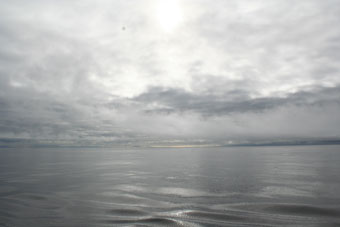

 | |||||||||
|
|
Journals 2007/2008Megan O'Neill
August 9, 2007 We continued to survey the floor with the multibeam and Chirp systems in the morning shift, but the seismics were set to begin at 9:00 am. Our location in the morning shift was 75°10.62´N and 15°29.90'E with a heading of 91.7 degrees N and speed of 7.8 knots. The depth to the sea floor was 310 m and the seas were very calm still. The air temperature had dropped slightly to 7.2° C, just like my father had e-mailed me and told me that the weather forecast mentioned it would get colder this weekend. He also mentioned that it was over 100° F with the heat index in North Alabama! I am not missing that in the slightest and am savouring being able to wear a coat, hat and gloves in August! At about 7:00 am during our shift, Miquel came in and said that he had seen some whales or baleen. Because the water was so very calm, you could see way off in the distance and there were several spouts shooting way into the air. They were too far even with the binoculars to see which kind of whales they were, but according to the chart for whale sightings, the spout indicated blue whales. It was a tall spout. It was beautiful also because some dark clouds were in the distance and it was the first time that the sky appeared darker than the water. The shades of blue that I have seen sky since I have been onboard are just phenomenal, between the water and the. It is such lovely scenery that I have not even considered the fact that I have not seen land since we left Longyearbyen on July 29th. That seems like decades ago now. At about 7:40 am the bridge called down to the lab and said that they were starting the transit line to the starting point for seismic acquisition. We will be travelling perpendicular to the lines travelled previously for the multibeam and Chirp. The reason for this is to get the points to match up to make a 3-dimensional picture of the areas once all the information is collected. At 12:30 pm, Paco gave a presentation on some of the work that he has done on interglacial and glacial periods in the history of the Earth. Based on ocean currents, data collected from core samples around the globe and glacial activity, they have been able to see similarities in the data and come up with possible conclusions about climate changes in the Earth's past. It was very interesting and amazing how scientists like Paco uncover the clues to help us understand how our planet works with only the information contained in the rocks and water. Paco's presentation was about problem-solving on the large scale and then onboard we had problem-solving on the smaller scale with the seismics. Problem solving is almost constant in science expeditions, so it is necessary to have all different types of people with different backgrounds and areas of expertise to come together to find solutions. The air gun that the technicians set up was working, but was leaking air, so it needed two air compressors running to be able to make it "fire". The streamer that had been planned to be used also was not functioning properly. They took apart a second air gun completely and cleaned and oiled it and put it back together in the hopes that it would work better. The streamer was just changed out with a shorter one that was available, which had less hydrophones for collection of the return waves, but is functional. At 19:30, once we reached the end of the first seismic collection line and were in transit to the next line, they changed out the air guns. This process includes using the crane on the back of the ship to haul the air guns in and out of the boat, as they are very heavy machines. Sure enough, once they put the new air gun in the water and hooked it up it worked much more smoothly and with only one air compressor, which is much quieter on deck than two. The technicians were elated! Their hard work paid off!
|
||||||||
